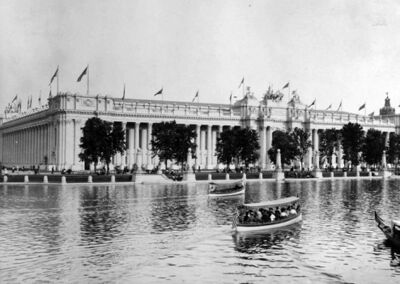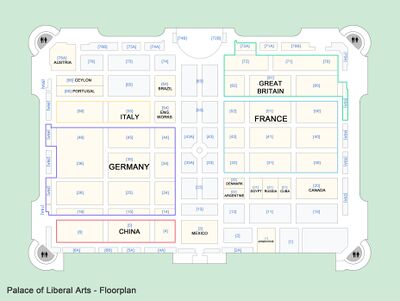Palace of Liberal Arts: Difference between revisions
No edit summary |
No edit summary |
||
| Line 35: | Line 35: | ||
Prior to the St. Louis World's Fair, liberal arts displays in expositions were displayed in departments of other palaces. This was the first time that a Liberal Arts building had it's own structure. | Prior to the St. Louis World's Fair, liberal arts displays in expositions were displayed in departments of other palaces. This was the first time that a Liberal Arts building had it's own structure. | ||
The palace was built by the Kellerman Contracting Company. | |||
Using its striking beauty to full effect, the | Using its striking beauty to full effect, the structure held the Fair's dedicatory exercises (topped off by President Roosevelt's visit), on April 30, 1903. | ||
Latest revision as of 23:26, 25 December 2022
 | |
| Location | Main Picture |
|---|---|
| No. of Buildings | 1 |
| Construction | |
| Construction Cost | $476,957 ($14.4 million in 2021) |
| Architecture | |
| Architect | Barnett, Haynes & Barnett of St. Louis |
| Dimensions | 525' x 750' |
 | |
The 9.1 acre Palace of Liberal Arts stood at the extreme east of the Main Picture, near the border of Forest Park, opposite the Palace of Mines & Metallurgy. Considered to be one of the most beautiful and ornate of the Fair's palaces, the Liberal Arts building was designed as a quadrangle.
Description[edit | edit source]
The main façade was enriched by three huge Roman triumphal arches; these were connected by a Doric colonnade and the corners were treated as round pavilions. The Palace of Liberal Arts was the most heavily staff-decorated of the Exposition palaces. The largest quadriga ever placed on any exposition and two flanking groups, standing atop the main triumphal arch were created by Charles Lopez and F. C. R. Roth. The Palace was designed with a grand inner court in mind, but construction had to be abandoned because of the great demand for exhibitor space. The building had eight entrances as well as sixteen emergency exits and housed a 400 seat restaurant.
Prior to the St. Louis World's Fair, liberal arts displays in expositions were displayed in departments of other palaces. This was the first time that a Liberal Arts building had it's own structure.
The palace was built by the Kellerman Contracting Company.
Using its striking beauty to full effect, the structure held the Fair's dedicatory exercises (topped off by President Roosevelt's visit), on April 30, 1903.
On display in the palace were actual surgical tools recovered from the ruins of Pompeii
Notable Exhibits[edit | edit source]
Countries[edit | edit source]
- France exhibit: included two huge searchlights and lenses, as well as Art Nouveau posters.
- Republic of Argentina: included scenic post cards, maps, scientific books and lithographic art.
- Great Britain: included coal tar and lectures pertaining to the experimentation with liquid air and hydrogen as well as governmental seals as far back as 790 AD. Another exhibit showcased coins from the British Mint.
- Mexico exhibit: included photographs, perfumes and assorted chemical products.
- Sweden exhibit: included a display of 'spunks' Sulphur-headed wooden stick matches.
- German exhibit: included a eclectic display of organ-making, canal building, children's books, sanitary work and signal lighting. The display also showcased luxurious bathrooms made from onyx.
- China exhibit: The St. Louis World's Fair marked the first time China officially participated in an international exposition. Displayed was a magnificent display of woodcarving, intricate furniture, ancient books and carvings, rare trophies from the Chinese temples, Chinese armor and weapons. The nation also showcased over 4,000 hand fans and models of 100 different types of boats. A seven foot long carved ivory elephant tusk valued at 16,000 dollars was shown. Also on display was a tree crafted from silver.
- Japan exhibit: included a complete newspaper office in operation.
- American exhibit: included an equatorial telescope, weighing two tons. Also on display was a full-sized reproduction of Southwest Pass Lighthouse created by Barnett, Haynes & Barnett of St. Louis.
- Louisiana exhibit: included old maps and books regarding the Louisiana Purchase. The oldest dating back to 1555.
Companies[edit | edit source]
- American Society of Civil Engineers exhibit: included displays of survey tools, and a huge model of a lighthouse. Also shown were how Swiss lake dwellers built their homes over water 3,000 to 5,000 years ago.
- Baldwin Piano Company exhibit: included a $56,000 (equivalent to $14,384,670 in 2021) display of the pianos as well as elaborate piano cases.
- Blickendorfer Company exhibit: included an early electric typewriter.
- C.G. Conn exhibit: included a jewel-studded gold coronet valued at $2,500 (equivalent to $14,384,670 in 2021).
- C.P. Goerz Optical Works: included a plant for grinding the lenses for cameras. They also displayed an early form of color photograph created by the Solgram Color Photo process (developed by William C. South).
- Doulton & Company showcased a chemical and pharmaceutical apparatuses.
- Hygenia Filter Company exhibit: included displays on water filtration. They provided visitors with samples of their filtered water.
- N.K. Fairbank Company exhibit: showcased Gold Dust and Fairy Soap cleaners. Their display was highlighted by a 22-foot fountain topped off with a statue of a fairy, billowing out 170,000 bubbles a minute. Another popular display was the company's cooking oil substitute they named Cottolene. They gave out free recipe booklets to promote this natural oil product.
- Photoscope Company of New York: had self-run photo booths that for a quarter, one could obtain six photo souvenirs of his/her visit.
- R. Hoe & Company exhibit: included a printing press capable of printing and folding 96,0000 8-page newspapers an hour.
- Regina Music Box Company exhibit: included a wide array of cylinder music boxes, including some styles that were built in furniture and clocks.
- Salvation Army exhibit: included huge backlit transparencies of is founder and their activities.
- Underwood Typewriters exhibit: was a gorgeous booth seemingly crafted in an Art Nouveau style out of typewriter parts. The company showcased typewriters that were suitable for multiple copies.
- Victor Talking Machine Company exhibit: An elaborate display in a Moorish style of the latest phonographs and Red Seal discs.
- Western Gas Company exhibit: included a vast display of the most advanced kitchen appliances at that time; from ranges, to lamps to ice chests and cheese graters.
